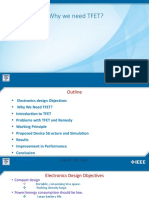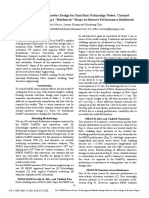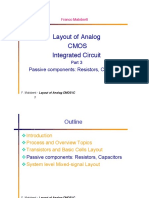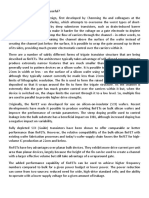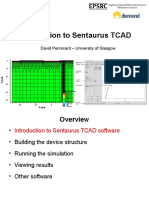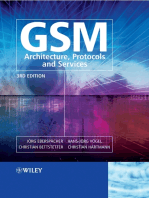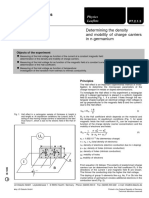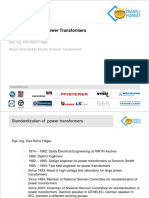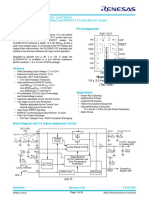Ieee Tfet
Ieee Tfet
Uploaded by
Nirman KhairnarCopyright:
Available Formats
Ieee Tfet
Ieee Tfet
Uploaded by
Nirman KhairnarOriginal Title
Copyright
Available Formats
Share this document
Did you find this document useful?
Is this content inappropriate?
Copyright:
Available Formats
Ieee Tfet
Ieee Tfet
Uploaded by
Nirman KhairnarCopyright:
Available Formats
Evaluation of Stability, Performance of
Ultra-Low Voltage TFET SRAM Cell With
Write-Assist Circuits
Kota Vinay Mishra Vishal Khairnar Nirman Dr. Sri Adibhatla Sridevi
VLSI Design VLSI Design VLSI Design Department of Micro and
VIT University, Vellore VIT University, Vellore VIT University, Vellore Nano Electronics
Kota.vinay2019@gmail.com Mishra.vishal1996@gmail.c nirmankhairnar7@gmail.co VIT University, Vellore
om m
Abstract— The down-scaling of conventional MOSFETs has
led to an impending power crisis, in which static power
consumption is becoming too high. In order to improve the
energy-efficiency of electronic circuits, small swing switches are
used to replace the MOSFETs used today. The stability and
performance of the proposed TFET 8T cell are used on TCAD
simulations based on published design rules for 20 nm technology
node. Tunnel FETs, which are gated p-i-n diodes whose on-
current arises from band-to-band tunneling, are attractive new
devices for low-power applications due to their low off-current
and their potential for a small sub threshold swing.
Keywords— Band-to-band tunneling, gated p-i-n diode, sub
threshold swing, tunnel field effect transistor (FET). TFET SRAMs, Fig:8T SRAM CELL
ultra-low voltage, write-assist circuits.
Write Operation:
INTRODUCTION During write 1 operation, Transistor M5 turns-on by enabling the
The introduction to the TFET is as follows, it includes its structure write word line signal. When the Bit Line‟ is imposed to logic1, then
and operation. A derivation of a band-to-band tunneling transmission Q node starts charging and turns on Transistor M1 which cause to flip
is carried out, and then the non-constant sub threshold swing of the Qbar node to logic 0. Now Qbar node helps enabling the Transistor
Tunnel FET is done, and some definitions are given. and then the M4 which facilitates writing good logic 1 at Q node. On the other
most important models used for the simulations in this thesis are hand, during write 0 operation, the Bit Line is imposed to logic 0 and
presented. The Small swing switches are introduced, and then in Transistor M5 turns-on by enabling write word line signal. The Q
particular, the Tunnel FET is described and its operation explained node starts discharging and turns on TransisitorM2 which in turn
and Finally, the history and state of-the-art of the Tunnel FET are flipped Qbar node to logic 1. Now Qbar node helps turning Transistor
given. Tunnel field-effect transistor (TFET) device with the band-to- M3 on, which facilitates discharging Q node properly and
band tunneling as the major current transport mechanism enables consequently logic 0 is obtained at Q node.
steeper than 60 mV/dec subthreshold swing, and is considered as a
promising device to replace MOSFET device for ultra-low Read Operation:
voltage/power operation. Read operation is performed by using MOSFETs M6, M7 and M8.
Node Qbar is connected to the gates of M7 and M8. In this case, a
SRAM current flows.
Static RAM is a memory unit, capable of storing one bit
(logic0/logic1)at a time.Two inverters are cross-coupled to form a
basic SRAM.Most of the electronics devices are manufactured with
this memory units.
READ AND WRITE OPERATION
Write access to the cell occurs through the write access transistors
and from the write bitlines, BL and BLB. Read access to the cell is
through the read access transistor and controlled by the read
wordline, RWL. The read bitline, RBL, is given to read access.
Fig. (a). Design of 8T SRAM Circuit using MOSFET
Fig:n-type TFET and p-type TFET
READ AND WRITE WAVEFORMS:
TFET:
The read and write waveforms of 8T SRAM cell are shown in Figure The basic TFET structure is similar to a MOSFET except that the
below. During the read the output is taken from read path and word source and drain terminals of a TFET are doped of opposite type .
line remains active high during write operation the input is applied at A common TFET device structure consists of a P-I-N (p-
Bit Lines and WL is asserted. During hold the WL remains off and type, intrinsic, n-type) junction, in which the electrostatic
cell is in idle state. potential of the intrinsic region is controlled by a gate terminal.
Fig. (b).Output Waveform
SIMULATION RESULTS:
The threshold voltage of pull down transistor is reduced by .
connecting body of the transistor to the negative terminal. Threshold Fig. Basic Schematic Of TFET
voltage of only NMOS transistor is increased because increase in Vth
results in increase in delay. That is speed of the circuit reducesto a DEVICE OPERATION:
greater extent. In first proposed work the pull up PMOS transistors The device is operated by applying gate bias so that electron
are stacked and threshold voltage of pull down transistors is increased accumulation occurs in the intrinsic region. At sufficient gate bias,
by reverse biasing its body. In second circuit pull down transistor is band-to-band tunneling (BTBT) occurs when the conduction band of
reverse biased and read Bit line path NMOS and PMOS are fixed. In the intrinsic region aligns with the valence band of the P region.
third circuit both pull up transistor and read line transistors are Electrons from the valence band of the p-type region tunnel into the
stacked and pull down. conduction band of the intrinsic region and current can flow across
the device. As the gate bias is reduced, the bands becomes misaligned
DEVICE DESIGN: and current can no longer flow.
Direct BTBT: In direct band to band tunneling,electrons travel across
In this work, we consider the PNPN type TFET for its capability to valence band and conduction band without absorbing or emitting
achieve sub-threshold swing below 60 mV/dec at room temperature. phonon.This type of tunneling takes place in GaAS,InAs etc.
The device structures of the PNPN TFET, NPNP TFET are shown in
Fig. a.Double-gate (DG) InAS structures are used, with the gate InDirect BTBT: In indirect band to band tunneling,electrons
length 20 nm, silicon body thickness 5 nm, equivalent oxide undergoes a change in momentum as they travel from valence band
thickness 0.6 nm, the source/drain doping of 4*10 19 cm-3 (p+) and to conduction band due to the absorption or emission of phonon. This
6*1017cm-3(n+).The TFET circuits are analyzed using TCAD type of tunneling takes place in silicon,germanium etc.
simulations.The PNPN TFET device can be seen to have superior
current drive and sub threshold slope at very low gate bias.While at DESIGN OF TCAD:
high gate bias, the current drive of PNPN TFET device is inferior to
the MOSFET. TCAD [R] stands for technology computer aided design. It is a
design technique for semiconductor devices and involves computer
simulation strategies to develop 2D/3D devices and simulate their [1] B V V Satyanarayana ,M.Durga Prakash, “Analysis of Heterojunc-tion
characteristics. Industry driving producer of TCAD tools is Synopsys Tunneling Architectures for Ultra Low Power Applications,” in Ponte
and they provide both device and process simulation tools. Sentaurus International Journal of Sciences and Research Vol. 73 | No. 10 | Oct 2017.
[2] K. Vanama, R. Gunnuthula and G. Prasad, "Design of low power stable
TCAD, the TCAD suite from the house of Synopsys offers
SRAM cell," 2014 International Conference on Circuits, Power and
construction of device structures, simulation, meshing, electrical Computing Technologies [ICCPCT-2014], Nagercoil, 2014, pp. 1263-1267.
characteristics visualization, performance parameter extraction., and [3] S. Gupta, K. Gupta and N. Pandey, "A 32-nm Subthreshold 7T SRAM Bit
curve plotting.First and foremost step in device simulation Cell With Read Assist," in IEEE Transactions on Very Large Scale
is making and meshing the device using Sentaurus device editor Integration (VLSI) Systems, vol. 25, no. 12, pp. 3473-3483, Dec. 2017.
(SDE). Output of this stage may be a script file of scm format. This [4] B. Majumdar and S. Basu, "Low power single bitline 6T SRAM cell with
script file is then run utilizing sde -e -l .scm. when completion, high read stability," 2011 International Conference on Recent Trends in
TCAD can generate the device structure. Extension of device Information Systems, Kolkata, 2011, pp. 169-174.
structure file is tdr. The tdr file is opened utilizing Svisual tool in [5] Y. Yang, H. Jeong, S. C. Song, J. Wang, G. Yeap and S. O. Jung, "Single
Bit-Line 7T SRAM Cell for Near-Threshold Voltage Opera-tion With
TCAD suite, to look at the device. Parameter file specific to the
Enhanced Performance and Energy in 14 nm FinFET Technology," in IEEE
device is to be further before simulation of electrical characteristics Transactions on Circuits and Systems I: Reg-ular Papers, vol. 63, no. 7, pp.
of the device. Parameters like tunneling are outlined, within the 1023-1032, July 2016.
parameter file. Device characteristics are generated by running the [6] A. Q. Ansari and J. A. Ansari, "Design of 7T sram cell for low power
command sdevice des.cmd. A plot file (.plt). Characteristics of the applications," 2015 Annual IEEE India Conference (INDICON), New Delhi,
device is aforethought by gap the plt file utilizing Svisual. 2015, pp. 1-4.
A picturing of TCAD tool flow is given in Fig. [7] X. Yang and K. Mohanram, "Robust 6T Si tunneling transistor SRAM
design," 2011 Design, Automation & Test in Europe, Greno-ble, 2011, pp. 1-
6.
[8] M. Yabuuchi, K. Nii, Y. Tsukamoto, S. Ohbayashi, Y. Nakase, and H.
Shinohara, “A 45 nm 0.6 V cross-point 8 T SRAM with negative biased
read/write assist,” in Proc. IEEE Symp. VLSI Circuits, Jun. 2009, pp. 158–
159.
[9] K. Osada et al., “Universal-Vdd 0.65–2.0-V 32-kB cache using a
voltageadapted timing-generation scheme and a lithographically symmetrical
cell,” IEEE J. Solid-State Circuits, vol. 36, no. 11, pp. 1738–1744, Nov. 2001.
[10] H. Jeong, T. Kim, T. Song, G. Kim, and S.-O. Jung, “Trip-point bit-line
precharge sensing scheme for single-ended SRAM,” IEEE Trans. Very Large
Scale Integr. (VLSI) Syst., vol. 23, no. 7, pp. 1370–1374, Jul. 2015.
[11] S. A. Tawfik and V. Kursun, “Low power and robust 7 T dual-V t
Table 1.Device parameter for NTFET AND PTFET SRAMcircuit,” in Proc. IEEE Int. Symp. Circuits Syst. (ISCAS), May 2008,
pp. 1452–1455.
Parameter NTFET PTFET [12] E. Seevinck et al., “Static-noise margin analysis of MOS SRAM
device device cells,”IEEE J. Solid-State Circuits, vol. SC-22, no. 5, pp. 748–754, Oct. 1987.
Source Doping Concentration [13] N. Edri, S. Fraiman, A. Teman, and A. Fish, “Data retention voltage
detection for minimizing the standby power of SRAM arrays,” in Proc. IEEE
Drain Doping Concentration 27th Conv. Elect. Electron. Eng. Israel (IEEEI), Nov. 2012, pp. 1–5.
Intrinsic Channel Doping [14] A Novel Virtual Grounding Based Read-Error Reduction Technique in
SRAM” International Journal of Research in Computer and Com-munication
Concentration
Technology, Vol 2, Issue 7, July-2013.
Gate Length(nm) [15] M. Mamidipaka et.al “Leakage Power Estimation in SRAMs,”Motorola
Oxide Thickness(nm) Co., USA, Sept. 2003
Radius of Silicon core
parameters NTFET PTFET
Threshold voltage(vtn) 0.24652V
Ion 16.8607ohm
Ioff 9.16544*10-6 A
Ron 0.00002573A
Idsat 0.000108155A
CONCLUSION:
The proposed 8T SRAM cell can be very useful for ultra-low power
applications operating voltage of 0.1V with reduced delay. The con-
ventional 8T SRAM cell is modified in two ways to optimize power
and delay. First, 8T with Read assist technique and second, 8T
SRAM using two Extra pass transistors.
ACKNOWLEDGMENT:
.
REFERENCES:
You might also like
- Medium Voltage Switchgear AHA: Up To 24 KV, Up To 5000 A, Up To 125 KaDocument78 pagesMedium Voltage Switchgear AHA: Up To 24 KV, Up To 5000 A, Up To 125 KaEdú Brizuela100% (1)
- Design High Speed, Low Noise, Low Power Two Stage CMOSDocument5 pagesDesign High Speed, Low Noise, Low Power Two Stage CMOSsanjeevsoni64No ratings yet
- CT-5083VB Kct-11aDocument12 pagesCT-5083VB Kct-11aDavid Argote Bellido100% (2)
- TFETDocument4 pagesTFETSurya KalagaNo ratings yet
- TCAD Simulation Analysis of Tri-Gate Soi Finfet and Its ApplicationDocument11 pagesTCAD Simulation Analysis of Tri-Gate Soi Finfet and Its ApplicationShankul SainiNo ratings yet
- GaN Research PaperDocument7 pagesGaN Research Papergurdiansky01No ratings yet
- Comparative Analysis of Different Architectures of CMOS ComparatorDocument4 pagesComparative Analysis of Different Architectures of CMOS Comparatorj4everNo ratings yet
- TFET MineDocument8 pagesTFET MineharismansuriNo ratings yet
- Silicon FINFET Device in 3DDocument9 pagesSilicon FINFET Device in 3DbhataviNo ratings yet
- TFETDocument69 pagesTFETkumarguptav100% (1)
- 457 Opamp 1 424Document28 pages457 Opamp 1 424v4vktryNo ratings yet
- Advanced MOSFET Structures and Processes For Sub-7 NM CMOS TechnologiesDocument74 pagesAdvanced MOSFET Structures and Processes For Sub-7 NM CMOS TechnologiesxellosdexNo ratings yet
- Noise Sources of MOSFETDocument11 pagesNoise Sources of MOSFETDerunNo ratings yet
- Layer Density Rules: Chapter 3 CMOS Processing TechnologyDocument1 pageLayer Density Rules: Chapter 3 CMOS Processing TechnologyCarlos Saavedra100% (1)
- AnalogICdesign-chapter5 - Current MirrorDocument28 pagesAnalogICdesign-chapter5 - Current MirrorPhạm Đức ThuậnNo ratings yet
- Analog Design Internship ReportDocument60 pagesAnalog Design Internship ReportAfzal MalikNo ratings yet
- Analysis of Sense Amplifier Circuit Used in High Performance & Low Power SramDocument5 pagesAnalysis of Sense Amplifier Circuit Used in High Performance & Low Power SramGJESRNo ratings yet
- Chip IO Circuit Design PDFDocument21 pagesChip IO Circuit Design PDFVăn CôngNo ratings yet
- FinFET/Nanowire Design For 5nm/3nm Technology Nodes: Channel Cladding and Introducing A "Bottleneck" Shape To Remove Performance BottleneckDocument3 pagesFinFET/Nanowire Design For 5nm/3nm Technology Nodes: Channel Cladding and Introducing A "Bottleneck" Shape To Remove Performance Bottleneckcowdung1No ratings yet
- Introduction To Cmos Vlsi Design: SPICE SimulationDocument28 pagesIntroduction To Cmos Vlsi Design: SPICE SimulationSarthak SharmaNo ratings yet
- Cadence - Virtuoso: Amity UniversityDocument27 pagesCadence - Virtuoso: Amity UniversityAkhil Aggarwal100% (1)
- Finfet: Soi and The Non-Planar Finfet DeviceDocument34 pagesFinfet: Soi and The Non-Planar Finfet Devicesandeeppareek926100% (1)
- Matching LayoutDocument41 pagesMatching Layoutvarun186No ratings yet
- Cmos IssuesDocument180 pagesCmos IssuessiddhasenNo ratings yet
- Analog ICDocument38 pagesAnalog ICRAJAMOHANNo ratings yet
- 6+yrs Analog Layout Resume RishikeshDocument5 pages6+yrs Analog Layout Resume RishikeshshubhadNo ratings yet
- CMOS ScalingDocument19 pagesCMOS ScalingnsrkntNo ratings yet
- Isscc2018 31 DigestDocument17 pagesIsscc2018 31 DigestJiaxiang LiuNo ratings yet
- Bandgap 2009Document27 pagesBandgap 2009jjloksNo ratings yet
- Rail To Rail Amplifier ProjectDocument19 pagesRail To Rail Amplifier Projectneva91No ratings yet
- Zipper Cmos Logic CircuitDocument15 pagesZipper Cmos Logic CircuitShreerama Samartha G BhattaNo ratings yet
- Analog-to-Digital Converter: Prof. Chung-Ta KingDocument41 pagesAnalog-to-Digital Converter: Prof. Chung-Ta KingSách ChánhNo ratings yet
- Phase Noise and Jitter in CMOS Ring OscillatorsDocument14 pagesPhase Noise and Jitter in CMOS Ring Oscillatorsnucleur_13No ratings yet
- Layout-Dependent Proximity Effects in Deep Nanoscale CMOSDocument8 pagesLayout-Dependent Proximity Effects in Deep Nanoscale CMOSVENKINo ratings yet
- Comparator Slides v1 - 0Document44 pagesComparator Slides v1 - 0Preeti BobdeNo ratings yet
- History of Finfet: Prasanna Kumar Minakshi KoreDocument10 pagesHistory of Finfet: Prasanna Kumar Minakshi KoreRohit Kumar S.SNo ratings yet
- Vlsi Test Structures For Process CharacterizationDocument76 pagesVlsi Test Structures For Process CharacterizationSumeet SauravNo ratings yet
- Common Mode Feedback and Differential AmplifiersDocument71 pagesCommon Mode Feedback and Differential Amplifiersreader_188No ratings yet
- 02 TCAD Laboratory Sentaurus TCAD GBB OLDDocument23 pages02 TCAD Laboratory Sentaurus TCAD GBB OLDarunNo ratings yet
- Antenna EffectDocument5 pagesAntenna Effectstudius1No ratings yet
- Eetop - CN MMIC DesignDocument207 pagesEetop - CN MMIC DesignA Mohan BabuNo ratings yet
- Low Power High Speed Cmos Comparator DesignDocument5 pagesLow Power High Speed Cmos Comparator DesignshuvamNo ratings yet
- Final ThesisDocument85 pagesFinal ThesiskrishnavadlamudiNo ratings yet
- What Is A FinFET and Why Is It UsefulDocument5 pagesWhat Is A FinFET and Why Is It UsefulYogeshGargNo ratings yet
- ECEN620 - Network Theory Broadband Circuit Design Fall 2014 Lec 15 - Delay Locked Loops (DLLS)Document29 pagesECEN620 - Network Theory Broadband Circuit Design Fall 2014 Lec 15 - Delay Locked Loops (DLLS)Apoorva Bhatt100% (1)
- Implementation of Components and Circuits: OutlineDocument26 pagesImplementation of Components and Circuits: OutlineTarundeep SinghNo ratings yet
- Design of Analog Integrated Circuits and SystemsDocument10 pagesDesign of Analog Integrated Circuits and Systemsecedeptt0% (1)
- DDR SdramDocument36 pagesDDR Sdramajmalpm333No ratings yet
- Introduction To Sentaurus TCADDocument47 pagesIntroduction To Sentaurus TCADvijayNo ratings yet
- A New CMOS Charge Pump For Low Voltage ApplicationsDocument4 pagesA New CMOS Charge Pump For Low Voltage Applicationskhausar1785No ratings yet
- Memory Design PDFDocument38 pagesMemory Design PDFarammartNo ratings yet
- Power Management For Battery Powered Equipment - Design GuideDocument24 pagesPower Management For Battery Powered Equipment - Design Guideohoboho79No ratings yet
- Lecture 5 - CMOS Transistor TheoryDocument44 pagesLecture 5 - CMOS Transistor Theorysadia santaNo ratings yet
- 2011 - Advanced Technology For High Performance & Low Power ApplicationsDocument12 pages2011 - Advanced Technology For High Performance & Low Power Applicationsambica207No ratings yet
- Great DLL ArticleDocument13 pagesGreat DLL ArticleRashidHamdaniNo ratings yet
- 2016 Ch2-MOS TransistorsDocument47 pages2016 Ch2-MOS Transistorsជើងកាង ភូមិ100% (1)
- Analog Sample Interview QuestionsDocument30 pagesAnalog Sample Interview QuestionsSampoornaGonellaNo ratings yet
- VLSI IntroductionDocument23 pagesVLSI IntroductionSreenivasulu MamillaNo ratings yet
- GSM - Architecture, Protocols and ServicesFrom EverandGSM - Architecture, Protocols and ServicesRating: 1 out of 5 stars1/5 (1)
- Types, Faults and Its AdvancementsDocument73 pagesTypes, Faults and Its AdvancementsBikash SubediNo ratings yet
- Half-Heusler Compound With Promising Thermoelectric PerformanceDocument14 pagesHalf-Heusler Compound With Promising Thermoelectric PerformanceHoàng Thu ThuỷNo ratings yet
- Aqa Elec4 W Ms Jun11Document8 pagesAqa Elec4 W Ms Jun11kazi juwelsNo ratings yet
- Department of Electrical & Electronics Engineering: Class Section Code-Subject Name of The FacultyDocument2 pagesDepartment of Electrical & Electronics Engineering: Class Section Code-Subject Name of The Facultyv srinivasNo ratings yet
- Beee - Unit 1 Notes - EnglishDocument20 pagesBeee - Unit 1 Notes - EnglishvsuryasNo ratings yet
- Compression of Electronic DevicesDocument7 pagesCompression of Electronic DevicesSuvam SahuNo ratings yet
- Midea Katalogas R410A All DC Inverter VRF V5 X Series UAB Anaga 2015Document90 pagesMidea Katalogas R410A All DC Inverter VRF V5 X Series UAB Anaga 2015Grupo Ouro PretoNo ratings yet
- RCD/MCB Combination Switch, 16A, 0.03A, B-LS - Char, 1Np, A-FI - Char Part No. PXK-B16/1N/003-A Catalog No. 236948Document2 pagesRCD/MCB Combination Switch, 16A, 0.03A, B-LS - Char, 1Np, A-FI - Char Part No. PXK-B16/1N/003-A Catalog No. 236948idayaalphapowerNo ratings yet
- Experiment3 GunnDiodeDocument4 pagesExperiment3 GunnDiodeRishikant KashyapNo ratings yet
- Ttp229-Bsf Tontouch: 16 Keys or 8 Keys Touch Pad Detector IcDocument16 pagesTtp229-Bsf Tontouch: 16 Keys or 8 Keys Touch Pad Detector IcitalotmaNo ratings yet
- Ellk92led CsaDocument12 pagesEllk92led Csajinyuan74No ratings yet
- KronDocument4 pagesKronDeepak Singh100% (1)
- Assembly and Parts Album: KDE12EA/EA3Document1 pageAssembly and Parts Album: KDE12EA/EA3Duvan Garridt MillanNo ratings yet
- LAB 1 - Electronics For Transmission SystemsDocument19 pagesLAB 1 - Electronics For Transmission Systemspablo orellanaNo ratings yet
- Solid-State Physics: Determining The Density and Mobility of Charge Carriers in N-GermaniumDocument6 pagesSolid-State Physics: Determining The Density and Mobility of Charge Carriers in N-GermaniumIhya UlumuddinNo ratings yet
- 4.12 ETH CableDocument4 pages4.12 ETH CableadinugrohoNo ratings yet
- An Analysis of Previous Blackouts in The World Lessons For Chinas Power IndustryDocument13 pagesAn Analysis of Previous Blackouts in The World Lessons For Chinas Power Industrymega oktavianiNo ratings yet
- EE669 Lecture Slides Module 1Document46 pagesEE669 Lecture Slides Module 1sivanaresh14No ratings yet
- DSD 412Document124 pagesDSD 412rusty shacklefordNo ratings yet
- Testing of DC MachinesDocument15 pagesTesting of DC MachinesMadhu TallapanenimadhuNo ratings yet
- Unit 3Document23 pagesUnit 3Prema ElizabethNo ratings yet
- Exploded View Parts List (UA32H4100AKXKE)Document9 pagesExploded View Parts List (UA32H4100AKXKE)Adedeji OluwatobilobaNo ratings yet
- 1 Electrostatics PDFDocument21 pages1 Electrostatics PDFsoumengoswami10No ratings yet
- Training ReportDocument49 pagesTraining ReportIsradani MjNo ratings yet
- Standardization of Power Transformers: Dipl.-Ing. Karl-Heinz Häger Alstom Grid GMBH Activity Schorch TransformersDocument30 pagesStandardization of Power Transformers: Dipl.-Ing. Karl-Heinz Häger Alstom Grid GMBH Activity Schorch TransformerseviNo ratings yet
- TOL3Cab Three-Phase Thermal Overload Protection For Cables: 1MRS752328-MUMDocument23 pagesTOL3Cab Three-Phase Thermal Overload Protection For Cables: 1MRS752328-MUMrajeshNo ratings yet
- slg59h1013v DatasheetDocument31 pagesslg59h1013v Datasheetlaprueba 300No ratings yet
- MCGGDocument14 pagesMCGGJesica Diaz Rodriguez100% (1)







